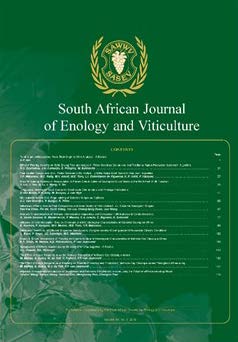The Effect of Grape Temperature at Pressing on Phenolic Extraction and Evolution in Méthode Cap Classique Wines Throughout Winemaking
DOI:
https://doi.org/10.21548/39-1-2621Abstract
Phenolic compounds are important quality indicators of wine. Their composition in wine is determined by various factors, including grape variety, terroir, viticultural practices and oenological practices. Thereis very little extraction of colour compounds and, generally, very little phenolic content is expected and desired during traditional sparkling wine (TSW) vinification. Since phenolics are thought to reduce ageing
capacity (Zoecklein, 2002), and are linked to browning in TSW (Ibern-Gómez et al., 2000), winemakers try to keep phenolic concentrations low throughout winemaking. This study investigated the effect of grape temperature at pressing on the phenolic extraction in Méthode Cap Classique (MCC) wines and the evolution of the phenolics throughout winemaking. MCC wines were made by the traditional method over two vintages (2014 and 2015) using Chardonnay and Pinot Noir grapes harvested from two regions (Robertson and Darling) and stored at 0°C, 10°C, 25°C and 30°C. MCCs made from grapes stored at lower temperatures (0°C and 10°C) were found to have lower total phenolic content, colour intensity and total hydroxycinnamates than wines made from grapes stored at higher temperatures (25°C and 30°C). This shows that there was greater phenolic extraction at higher temperatures. No changes in the phenolic content were observed throughout winemaking.
Downloads
Downloads
Additional Files
Published
Issue
Section
License
A copyright form will be e-mailed to the corresponding author when the manuscript has been accepted for publication.
In principle, the Author agrees to the following when he/she signes the copyright agreement:
I hereby assign to the SOUTH AFRICAN SOCIETY FOR ENOLOGY AND VITICULTURE (SASEV) the copyright of the text, tables, figures, supplementary material, illustrations and other information (the Material) submitted with the manuscript to be published in SOUTH AFRICAN JOURNAL OF ENOLOGY AND VITICULTURE (SAJEV) (the "Article"). The copyright becomes effective from the date the Article has been accepted for publication in SAJEV.
This is an open access journal, and the authors and journal should be properly acknowledged, when works are cited.
Author's may use the publishers version for teaching purposes, in books, theses, dissertations, conferences and conference papers.
A copy of the authors' publishers version may also be hosted on the following websites:
- Non-commercial personal webpage or blog.
- Institutional webpage.
- Authors Institutional Repository.
The following notice should accompany such a posting on the website: This is an electronic version of an article published in SAJEV, Volume XXX, number XXX, pages XXX - XXX, DOI. Authors should also supply a hyperlink to the original paper or indicate where the original paper (www.journals.ac.za/index.php/sajev/) may be found.
Authors publishers version, affiliated with the Stellenbosch University will be automatically deposited in the University's Institutional Repository SUNScholar.
Articles as a whole, may not be re-published with another journal.
The following license applies:
Attribution CC BY-NC-ND 4.0

